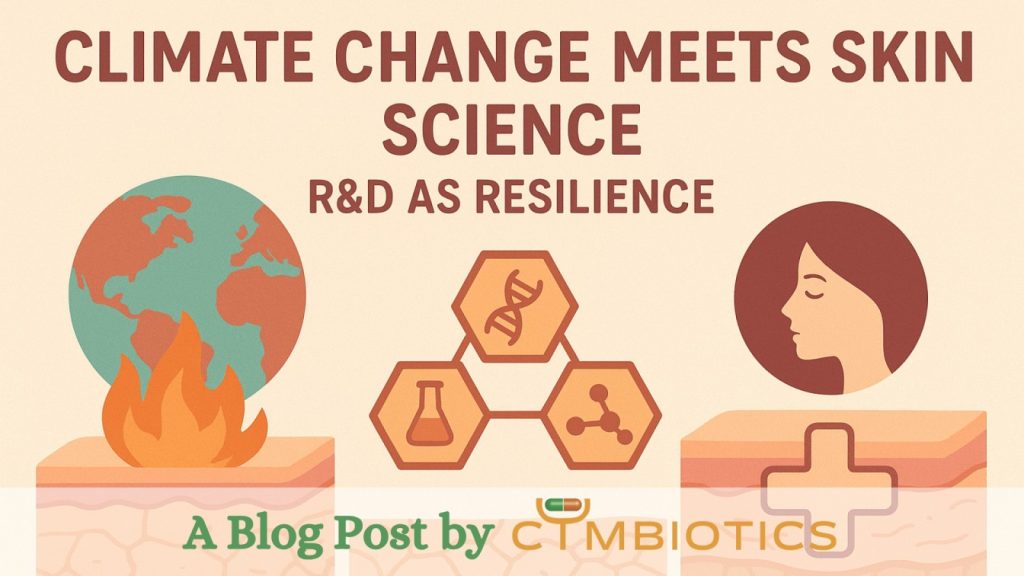October 24 marks the International Day of Climate Action, a day typically anchored in sweeping global statistics, rising sea levels, and carbon budgets. Yet the most immediate interface of climate change is far more personal and smaller still: it’s your skin. The largest human organ, constantly exposed to the air, the ultraviolet flux, and the ambient environment, becomes the first biological surface to reflect climate shifts. At Cymbiotics, the pivot isn’t just about cosmetic protection; it’s about formulation for resilience, where skincare R&D becomes climate-adaptation science.
Skin as the frontline of climate stress
When the climate system destabilises, higher heat waves, greater UV intensities, surges in particulate matter, more volatile humidity cycles; the skin registers it first. Think of the skin’s ‘microclimate’ as a miniature atmospheric layer under continuous assault. Elevated ambient heat raises transepidermal water loss (TEWL) and thins the barrier; polluting particles embed and ignite oxidative cascades; erratic humidity swings disrupt the cutaneous microbiome and lipid balance. These are not just episodic discomforts, they are evidence of barrier disruption in real time.
Under the microscope: how climate stress translates to biology
- Heat and humidity extremes: Studies show that both high ambient temperature and low humidity can worsen skin barrier function, increasing TEWL and reducing hydration. For example, a prospective study found hot-water immersion nearly doubled TEWL compared to baseline conditions.
- Particulate matter (PM) exposure: PM₂.₅ and other fine pollutants have been shown to undermine key barrier proteins (e.g., filaggrin), increase TEWL, and provoke oxidative stress in keratinocytes and reconstructed skin models.
- Pollution & ageing link: A systematic review concluded that exposure to air pollutants correlated with extrinsic skin ageing, inflammation, and barrier dysfunction, highlighting that environmental stressors accelerate dermatological decline.
These mechanisms take us beyond “dry skin” or “sensitivity” to a deeper paradigm: the skin barrier is no longer just reacting, it’s adapting (or failing to adapt) to a changing environment.
Why dermatology is shifting from beauty to resilience
Historically, skincare centred on improving what was visible, fine lines, dryness, hyperpigmentation. Today, the imperative has broadened: how does the skin withstand accelerated environmental change? On this day of climate action, it’s worth reframing: protecting skin isn’t indulgence, it’s adaptation. When the environment becomes unpredictable, skincare must stabilise what cannot easily stabilise itself. The context shifts from “repair” to “resilience” and from “beauty” to “bio-function”.
The innovation gap in skincare
Most mainstream solutions still operate on a legacy model: ingredients that hydrate, soothe, soften. But climate stress demands something more: preventive, adaptive, stable under fluctuating stressors. Simply loading actives will not suffice if the barrier cannot maintain integrity. The challenge becomes: how to deliver stability, not just comfort? How to enable the skin’s microenvironment to remain constant when the macroenvironment is anything but?
Where Cymbiotics fits in
At Cymbiotics, the research mandate is explicit: build formulations that moderate the micro-environment of the skin in the face of external instability. Our technologies emphasize barrier intelligence, microclimate regulation, and sustained cellular equilibrium. We focus on delivery systems and functional stability, devices that allow the skin to adapt, rather than just respond. In an era where climate change is rapid and multi-vector, this shift from reaction to adaptation is crucial.
Closing vision: R&D as resilience-building
Climate change begins at the surface, and so does adaptation. If the environment is shifting faster than biology can recalibrate, then skincare must move faster still. At this moment, formulation science is less about preference and more about preparedness. Because protecting the planet includes protecting what encounters it first, the skin. R&D must therefore be framed not just as a response, but as resilience-building: pre-emptive, scientific, and future-forward.
On this International Day of Climate Action, the message is clear: skin health is climate health. And the future of skincare is adaptation.
References
- “Impact of Water Exposure and Temperature Changes on Skin Barrier Function in Healthy Individuals”
Marías Herrero-Fernández, Teresa Montero-Vílchez, Pablo Díaz-Calvillo, et al.
- “Particulate Matter and Its Molecular Effects on Skin”
Jiyoung Kim, Dayeong Kim, Yejin Kim, et al.
- “Global Warming and Implications for Epithelial Barrier Disruption and Disease”
Laurence Rittié, et al.
- “Oxidative contribution of air pollution to extrinsic skin ageing”
Julia C Fussell, et al.


